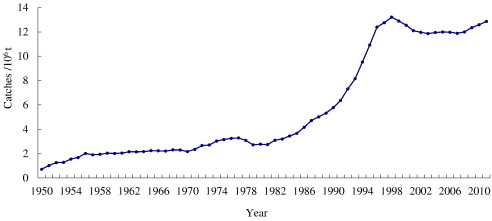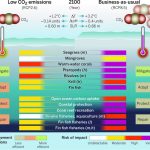William Cheung, Director of the Nereus Program (Science) and Principle Investigator, has published two papers on Chinese marine areas, including on the impacts of fishing on the mean trophic level and comparing trophic structure.
“Impacts of fishing on the marine mean trophic level in Chinese marine area” (DOWNLOAD PDF) has been published in Acta Ecologica Sinica.
Abstract:
Studying the long-term effects of fishing on the marine mean trophic level (MTL) is very important for understanding the status of marine ecosystems, and it will help in the design of appropriate conservation management strategies. Using data on fishery landings from the FAO Fishery Statistics (FishStatJ_2.0.0_win32, 1950 to 2011), we analyzed changes in the fishery landings of 51 marine species/groups in the Chinese marine area and their impacts on MTL. We obtained the following results: China’s fishery landings increased gradually from 0.72 × 106 t to 3.29 × 106 t between 1950 and 1977; it increased sharply from 2.74 × 106 t to 13.21 × 106 t between 1981 and 1998, declined to 12.00 × 106 t in 2002 and remained relatively stable until 2008, and increased again to 12.86 × 106 t between 2009 and 2011. The percentage of landings from species/groups whose trophic level was higher than 3.5 was about 28% in 1975–1977; it declined to 17.1% in 1979–1981, increased to 27.00% in 1979–1981, declined from 24.57% to 13.64% in 1982–1988, fluctuated around 19.43% in 1997, and then increased steadily to 35.8% from 1997 to 2011. China’s MTL remained stable from 1950 to 1974, fluctuated slightly around 3.45, declined to 3.35 in 1975–1978, and increased to 3.45 in 1979–1981. However, the MTL declined sharply to 3.25 in 1982–1987 and remained stable 10 years afterwards. The decreasing rate of MTL was 0.05 per decade during 1950–1997; it increased gradually to 3.34 from 1997 to 2011, during which the increasing rate was 0.12 per decade. The fishing in balance index of Chinese marine area showed a clear increasing trend since 1950; the trend was greater than 0.5 since 1959, and it increased to greater than 1 since 1995. The changes in MTL were closely related to the composition of the fish species/groups in the total fishery landings, especially the fish species/groups of which the MTL was greater than 3.5, such as Trichiurus haumela, Larimichthys polyactis, Larimichthys crocea, Engraulis japonicas, and Decapterus spp. The general declining trend of MTL indicates that the dominant fishery landings changed from benthic fishes with a long life span and high trophic level (e.g., T. haumela) to invertebrates and pelagic fishes with a short life span and low trophic level (e.g., Decapterus spp.). The increase in MTL in China from 1997 to 2011 may be attributable to a series of fishery management countermeasures, such as setting up closed fishing seasons and non-fishing zones, establishing marine protected areas for fishery restoration. We also found that MTL may differ when statistical landings data and species richness data are used, and may be affected by the quality of the fisheries statistics. Moreover, species’ trophic level, which is assumed to be constant, may have changed over time. The effects of these factors on MTL should be explored in the future.

Fig. 1. The changes of fishery landings in China’s offshore (1950–2010).
Also, published in Ecological Modelling is “Comparing trophic structure of a subtropical bay as estimated from mass-balance food web model and stable isotope analysis” (DOWNLOAD PDF).
Abstract:
The trophic structure of a subtropical bay in Taiwan Strait was analyzed by using two methods: mass balance modeling (Ecopath) and stable isotopic analysis (SIA). Trophic levels (TLs) of main functional groups estimated from the two methods were compared. The Ecopath model was built based on the fishery resource survey in Xiamen Bay in 2009. Specifically, data on species composition, biomass, mortality rates, diet composition and fisheries catches were obtained from the survey in and around the bay. The model consisted of 26 functional groups, including plankton, benthos, fish, cephalopods, shrimps, crabs and marine mammals. TLs of the main functional groups were estimated to be between 2.89 (cephalopods) and 3.94 (congers), with an average of 3.11. Trophic transfer efficiencies from levels II to V were 12.8%, 19.2%, 19.7% and 12.1%, respectively. Catfish (Tachysurus sinensis and Netuma thalassina) and the fisheries have major trophic impacts on most functional groups in the Xiamen Bay ecosystem. Total system throughput was estimated to be 411 t km−2year−1. TLs derived from isotopic analysis were highly correlated with those estimated from Ecopath (Linear regression: R2 = 0.696, n = 23, p < 0.001). On an average, Ecopath underestimated TLs of the functional groups by about 12.2% compared to those estimated from SIA, with TLs from Ecopath being slightly higher at low TLs and lower at high TLs. This studies support value of using both stable isotopes and Ecopath methods to analyze this food web.
READ MORE: William Cheung, ecosystems, biodiversity








